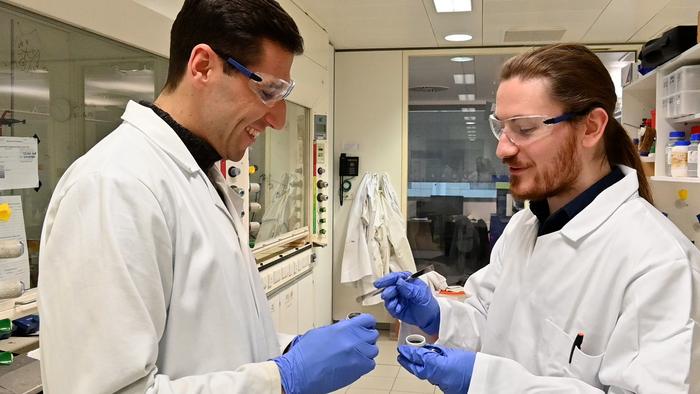
Oxford Chemistry researchers have unveiled a groundbreaking method to address the environmental concerns surrounding per- and polyfluoroalkyl substances (PFAS), commonly referred to as “forever chemicals.” This new approach not only paves the way for the destruction of these long-lived contaminants but also allows for the recovery of valuable fluorine, ensuring its reintroduction into industrial applications. Highlighted in a recent publication in the esteemed journal Nature, this innovative methodology represents a significant step forward in the quest to manage these persistent pollutants.
PFAS have been manufactured in substantial quantities for over seven decades, primarily due to their unique chemical properties, which include remarkable resistance to degradation. This chemical resilience has contributed to PFAS accumulating in the environment at alarming rates. These compounds are ubiquitous, found in a myriad of products such as non-stick cookware, food packaging, and textiles. As a result, PFAS contamination has emerged as a global concern, with traces detected in drinking water, wildlife, and even human blood plasma. The persistent nature of these chemicals has raised alarm bells, compelling researchers and environmentalists to seek comprehensive solutions.
The pressing challenge posed by PFAS necessitates the development of innovative technologies capable of efficiently detecting, recovering, and destroying these chemicals. The University of Oxford team, in collaboration with researchers from Colorado State University, has made substantial advancements in this area. By employing a mechanochemical method that involves the use of potassium phosphate salts, the researchers have demonstrated the capability to break down various PFAS compounds while recovering their fluorine content for subsequent reuse.
The process begins with the mechanical grinding of PFAS samples in conjunction with potassium phosphate salts. This method involves utilizing ball bearings to facilitate the breakdown of the chemical bonds within PFAS molecules. As the grinding occurs, the long-lasting bonds of the PFAS chemicals are disrupted, leading to the liberation of fluoride ions. Subsequently, these fluoride ions can be harnessed for generating critical fluorinating agents utilized in various industrial processes, including the pharmaceutical and agricultural sectors.
Crucially, this approach offers a dual benefit: the destruction of PFAS waste while enabling the sustainable reuse of fluorine. This closed-loop system aligns with the principles of a circular economy, addressing the environmental issues associated with fluorine production while simultaneously promoting resource recovery. The significance of this innovation extends beyond environmental remediation; it highlights the importance of developing strategies that not only diminish waste but also contribute to the replenishment of essential industrial resources.
One of the standout features of this breakthrough is its operational simplicity. The mechanochemical process negates reliance on complex chemical reactions or hazardous substances. Instead, it leverages physical forces to catalyze the degradation of PFAS compounds, a characteristic that sets it apart from conventional methods. Dr. Long Yang, one of the lead authors of the study, emphasized the potency of this innovative approach in providing a powerful solution to a highly complex environmental challenge.
The methodology also encompasses the potential to treat a diverse range of PFAS classes, extending its applicability to widely used products, from non-stick coatings to industrial insulation materials. This versatility resolves the pressing issue of PFAS disposal and pollution management by converting these hazardous waste products into valuable industrial inputs. The team envisages a future where everyday items, such as Teflon tape, can be repurposed into vital fluorochemicals essential for various sectors.
Significantly, the team’s findings underscore the implications for the global fluorochemical industry. With fluorspar, the primary mineral source for fluorine production, facing depletion due to extensive mining, this innovative process provides a pathway to mitigate dependency on raw material extraction. The reclaimed fluoride can reintegrate into the supply chain, thereby supporting a more sustainable approach to fluorine chemistry.
In addition to promoting sustainability, this research aligns with global efforts to mitigate the health risks associated with long-term PFAS exposure. As ongoing studies reveal potential links between PFAS and adverse health outcomes, the urgency to develop effective destruction and recovery methodologies intensifies. The implications of this research extend far beyond academic interest; they touch upon public health, environmental justice, and the preservation of ecosystems.
Professor Véronique Gouverneur, the principal investigator of the study, remarked on the vital significance of fluoride recovery in an era of dwindling resources. By converting persistent pollutants into valuable fluorinated chemicals, this study offers a pragmatic approach to addressing a critical environmental crisis. The collaborative efforts between Oxford and Colorado State University reinforce the importance of interdisciplinary partnerships in driving innovation and producing actionable solutions.
As the academic community and industry stakeholders take notice of these developments, the advancement of PFAS destruction technologies stands as a testament to the power of scientific inquiry and collaboration. Researchers remain committed to refining these methods, seeking further improvements in efficiency, scalability, and applicability to a broader spectrum of PFAS compounds. The continued focus on innovative approaches promises to transform the narrative surrounding PFAS and illuminate pathways toward environmental restoration.
In conclusion, the development of a mechanochemical process for PFAS destruction and fluorine recovery by researchers at the University of Oxford and Colorado State University represents a watershed moment in environmental chemistry. This revolutionary methodology provides a solution to an enduring environmental problem, embodying the principles of sustainability and circular economy. As the world grapples with the consequences of PFAS contamination, the significance of this research cannot be overstated, paving the way for cleaner production processes and a healthier planet.
Subject of Research: PFAS Destruction and Fluoride Recovery
Article Title: Phosphate–Enabled Mechanochemical PFAS Destruction for Fluoride Reuse
News Publication Date: 26-Mar-2025
Web References: Nature – DOI link
References: Nature 2025
Image Credits: Department of Chemistry, University of Oxford
Keywords
PFAS, recycling, environmental chemistry, sustainable processes, fluorine recovery, circular economy, chemical degradation, public health, industrial applications, innovation, sustainable development.
Tags: breakthrough research in environmental chemistrychemical resilience of perfluoroalkyl substancescomprehensive solutions for PFAS issuesdetection technologies for PFASenvironmental impact of forever chemicalsglobal concern over PFAS contaminationindustrial applications of recovered fluorineinnovative methods for PFAS destructionmanagement of persistent pollutantsPFAS in drinking water and wildliferecovery of valuable fluorinerecycling fluoride from PFAS





